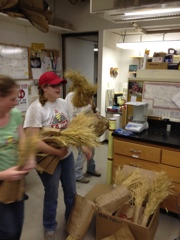 So, it has been another great summer in the lab with another great crew (pictured to the right is everyone but Sean and Kelli). Sure there is plenty of work left to do in order to finish out the season; however, about 1/3 of the lab will be left after most of them go back off to school next month. So, I took the opportunity to take a photo today. I got a bit carried away this year and designed t-shirts for the lab.
So, it has been another great summer in the lab with another great crew (pictured to the right is everyone but Sean and Kelli). Sure there is plenty of work left to do in order to finish out the season; however, about 1/3 of the lab will be left after most of them go back off to school next month. So, I took the opportunity to take a photo today. I got a bit carried away this year and designed t-shirts for the lab.There is sort of a Nebraska story and tradition that explains the "entomology blackshirts" shirts that we are wearing. According to Wikipedia, "The Blackshirts are the first-string defensive unit players for the Nebraska Cornhuskers football team." The short of it is that Nebraska football coaches in the 1960s began giving out black shirts to their top defensive teams. It eventually became a tradition where players had to "earn" their black practice shirts and at some point the entire Nebraska football defensive line became popularly known (at least in Nebraska and to all Husker fans) as "Blackshirts". So I felt it apt to hand out my blackshirts about mid-season once the summer crew had earned them. You can see the shirt fronts in the photos. The symbol for the Husker Blackshirts is often a skull and crossbones. Therefore, obviously, the back of the shirts have a screen print of Acherontia lachesis (the death's head hawkmoth, of Silence of the Lambs fame). There are actually three species of Acherontia that are commonly known as death's head moths. However, Acherontia lachesis could be roughly translated from old Greek as "proportioner of pain" and I kind of like the ring of that. This may seem as a bit of an eccentric act; however, a well-rooted team needs a bit of mythology and I have got a rock-solid crew deserving of my gratitude. Go team!




